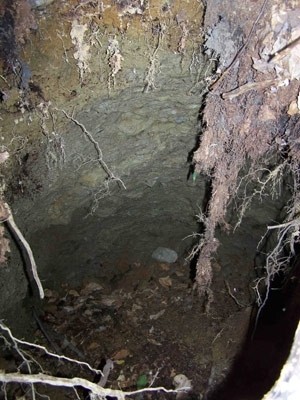My friend E’s a barrel-chested logger who lives down in southwestern Vermont. He’s a tough hombre, as is anyone who makes their living cutting trees. I’ve seen him bull his skidder up vertical inclines with complete disregard for the laws of gravity – inclines that would have made a sane driver wet his pants. The man can fell a 30-inch oak against the lean and hit a soda-can target 10 times out of 10. Tree starts coming down, guys like me scamper down our escape routes, E lets loose a sluice of Skoal, walks the tree down, and is already limbing by the time it stops shaking.
Now the flip side of this coin is that he’s scared of bees. And bats. And spiders. He’s basically scared of the woods. Coyotes. Thunderstorms. Oh, and sink holes.
Why just the other day he was backing up to a hitch of logs – down on the Taconic range – when lo and behold the ground gave way beneath his rear skidder tire. He was able to drive out, but when he went back to investigate, he found an enormous hole, maybe 6 feet across and 15-20 feet deep.
“I called it a day,” he told me later. “I’ve seen enough movies to know that if the ground starts opening up, you get out of there and you don’t go back.”
Anyway, I traipsed up the hill to see what he was talking about. Sure enough, the hole was impressive. And odd. There was no external indication that the ground was hollow underneath. There were no springs or water nearby that could have caused subterranean erosion. There were no old foundations or cellar holes that would indicate that it was a former well or root cellar. There was just a random hole – a big, vertical shaft sitting smack in the middle of a mountain.
I sent a picture of the hole to Larry Becker, the Vermont State Geologist, and asked him whether he thought the hole was man-made or natural in origin. Here’s what Larry had to say about the natural-origin theory:
“In Vermont, we do have places that are defined as karst terrain. Our examples are much less dramatic than say the cave systems and sink holes in Kentucky, but caves do exist in Vermont and openings is the limestone or marble formations do occur.
That said your picture also seems to have characteristics of a pot hole. When the glaciers were retreating from Vermont, so much water was discharging from the ice that pot holes were formed in places where the water ran. These places are now high and dry and not near a stream. Also another possibility - some of that glacial water infiltrated into the ground, dissolving some of the limestone/marble rock, and now groundwater is lower, which could account for a hole that today does not have any water in it. Also, an opening can continue to be dissolved by today’s precipitation infiltrating into the ground as the water makes its way to the water table below.”
As for man-made possibilities, the mountain did feature a marble mine in the 1800s. While the mine itself sits a half-mile down the mountain, perhaps this hole was a test pit of some sort? The two sites do sit at similar elevations. Perhaps the miners dug the pit and covered it with boards, which allowed tree roots and detritus to form a covering before the boards rotted away?
I don’t have an answer, but thought I’d blog about it in hopes that perhaps some of you out there have come across similar phenomenon in your woods. Any suggestions you have on what could have caused this sinkhole would be appreciated.
As for E, he’s back on the job. A safe distance away from the sinkhole, but cutting again, anyway. Now if only we could do something about those damn bees that buzz through the skidder cage with terrifying regularity…


